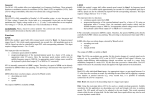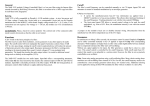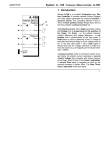Download General Set-up Functions CV-inputs
Transcript
General The VCA module (Voltage Controlled Amplifier) is a classic amplifier to control audio- and CV-signals either manually or with additional control voltages. The VCA uses a logarithmic control curve that is optimized for audio signals. Although a linear curve maybe more appropriate, the module can still be used to control CV-signals. The module’s specialty lies in its two dependent CV-inputs. With these, you are able to create patches that would normally require two VCAs. Set-up VCA is fully compatible to Doepfer’s A-100 modular system - in size, bus-power and CV/Gate voltage. Connect the 16-pin cable to a corresponded 16-pin jack on the Doepfer mainframe bus or the MIDI/CV circuit board. Supply voltage needs to be +/- 12 volts, 5-volt connections are not required. The wattage is +/- 20 mA, the module size 8 TE (Teileinheiten) or 40 mm. ATTENTION: Please, check for correct polarity! The colored side of the connector-cable needs to point downwards so that the cable is not twisted. Functions VCA offer three different inputs for audio signals or CV-sources. In1 has a corresponding attenuator. In2 and In3 do not have attenuation controls but different input sensitivities. These are not meant for signal mixing but as alternative inputs for differing signals. Gain manually sets the amount of amplification applied to the input signal. With settings above five, the input signal will be passed to the output, with control voltage being present. This is useful you previewing a patch without a keyboard or sequencer being present to supply gate signals. The output signal (audio or CV) is send to two parallel outputs. Out1 offers fixed level, while Out2 has a corresponding attenuator for manual output level control. CV-inputs Two CV-inputs allow external control over amplification. CV1 is typically connected to an envelope generator. CV2 input is special since it depends on CV1 input being used. Any control voltage applied to CV2 will only be active, with a present control signal at CV1. A useful application is the creation of a tremolo effect. Here, CV1 is under control of an envelope that shapes the sounds volume. A LFO signal is now send to CV2 to perform cyclic volume modulation. The result is a tremolo effect that is only audible as long as a key is held. With typical parallel inputs of other VCA modules, you would need to use an additional VCA to achieve the same effect. Operating Manual VCA Module






